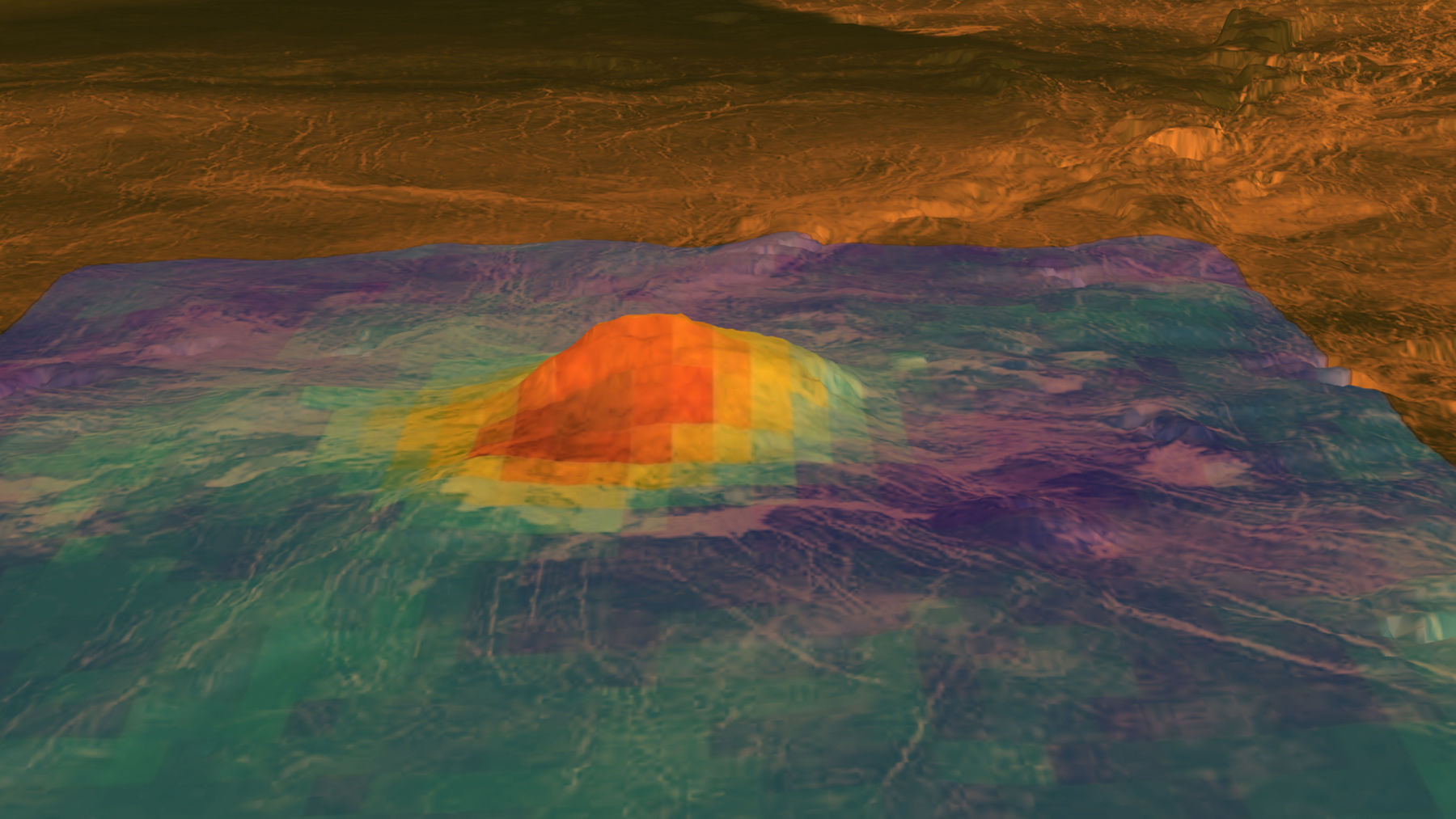Create a free profile to get unlimited access to exclusive videos, sweepstakes, and more!
I'm your Venus, I'm your fire

Goddess on the mountain top
Burning like a silver flame
The summit of beauty and love
And Venus was her name
— Shocking Blue/Bananarama
Is Venus dead? Maybe not.
First, a way cool picture:
[Click to hugely embiggen. Note (added February 11, 2012): the vertical scale is exaggerated by 30x to show features more clearly.]
That's Idunn Mons, a mountain on Venus as radar mapped a few years back by the Magellan space probe. The color overlay is a brand spanking new thermal (temperature) map using an infrared detector on the European Venus Express probe, currently orbiting our sister planet. Red is warmer, and as you can see, Idunn appears to be trying to tell us something.
But what's it saying? OK, here's the back story: If you needed to write a compare-and-contrast essay about Earth and another planet, you could hardly pick a better one than Venus. It's a lot like the Earth: it has almost the same diameter (12,100 km versus Earth's 12,740), it possesses about the same mass (5 versus 6 x 1024 kilos), it orbits the Sun a bit closer in than we do (109 million km versus 147). The total carbon content of the planet is similar to ours, too.
But it's also a lot different. While ours is locked up in the oceans and rocks, Venus has all of its CO2 in its atmosphere, which has caused a runaway greenhouse effect. The pressure at the surface is 90 times ours, and the surface temperature is 460° C (almost 900° F). It's an alien planet, in every sense of the word.
We also thought it was dead, geologically speaking. Despite showing mountains and other interesting features, maps of Venus indicate that the surface hasn't appeared to change much over geologic times. We have a pretty good grasp of how its atmosphere works, and the weathering processes it subjects the surface to -- which is not be to be trifled with, since the air there is laced with sulfuric acid and a hint of fluorine and chlorine compounds, too. According to all that, the surface looks to have been pretty stable for quite some time.
But that idea might be changing. New studies indicate Venus may have been volcanically active in the recent past, and may indeed still be active!
The atmosphere of Venus is opaque to our eyes (and highly reflective, which is why Venus looks so bright to us from Earth), but the VIRTIS instrument -- which stands for the Visible and Infrared Thermal Imaging Spectrometer -- on Venus Express was specifically designed to peer through the muck and look at the planet's surface. It can see temperature differences on the ground there, and when scientists studied the maps, they found several spots where the surface appears to be slightly warmer than you'd expect.
And very interestingly, at least some of these spots on Venus are also associated with raised features (0.5 to 2.5 km (.3 to 1.8 miles)) above the average surface height -- mountains, or, perhaps, volcanoes.
The image at the top of this post shows one such area, which is clearly a mountain of some kind in the Imdr Regio area of Venus. The surface on the top of the mountain is a few degrees warmer than the area around it, suggesting the existence of a hot spot under the surface. It's very hard to look at that and not think it's a volcano with a magma chamber under it. The data also indicate flow features that are much less weathered than expected, and therefore most likely very young.
How young is young? According to the team of scientists who took this data, this indicates that Venus was geologically active no more than 2.5 million years ago, and these features may have formed as little as 250,000 years ago! That's very young indeed when talking about the geologic clock of a planet -- that's more recent than the last Yellowstone eruption in the American northwest, for example. And the fact that the hot spots are still around is a strong indicator that activity is still present on Venus.
Of all the planets in the solar system, Venus gets closest to Earth -- it can be as little as about 40 million km (24 million miles) away, compared to Mars which can only get as close as 55 million km (33 million miles). Yet we know less about Venus than Mars. There are many reasons: Venus never strays far from the Sun in the sky, making it more difficult to observe than Mars, and as mentioned above its atmosphere is opaque.
But it's very much worthy of our study. Why did Venus suffer such a catastrophic runaway greenhouse effect? Why is its surface apparently pretty much all one age (except for this new result)? Why are there hot spots, and are they like ours here on Earth?
Studying the Earth is obviously an incredibly and critically important job for science. And as much as we learn studying it, we need other examples of planets to help us test our ideas. When I was a kid in middle school, I hated having to write those compare-and-contrast essays. But as a scientist -- and as a human living in a thin habitable bubble on a planet we have barely begun to understand -- I know we need them desperately.



























